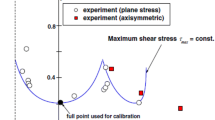Abstract
The instability and fracture process during uniaxial tension was observed from load-stop tensile tests and finite element simulation. The results indicate that at the end of instability, the direction of the maximum principle stress near the necking groove turns to being perpendicular to the groove. This tensile stress is critical to the growth of fracture. The fracture initiates from the internal of the sheet at the center of volume where the two local necking grooves intersect. Material here is under triaxial tensile stress state and the principle stresses in all three directions are the largest. Once the initial crack occurs, it propagates along the zero-strain-rate necking groove. Moreover, the final fracture angle between the fracture plane and the tensile axis is always larger than theoretical value. An important reason is the ignorance of the triaxial stress state evolution during instability in theoretical calculation.












Similar content being viewed by others

References
H. Vegter, H. Mulder, P.V. Liempt, and J. Heijne: Work hardening descriptions in simulation of sheet metal forming tailored to material type and processing. Int. J. Plast. 80, 204 (2016).
P.S. Ghangrekar, R. Banjare, B.C. Rao, and H. Murthy: Tensile testing of Al6061-T6 microspecimens with ultrafine grained structure derived from machining-based SPD process. J. Mater. Res. 29 (11), 1278 (2014).
K. Chung, H. Kim, and C. Lee: Forming limit criterion for ductile anisotropic sheets as a material property and its deformation path insensitivity. Part I: Deformation path insensitive formula based on theoretical models. Int. J. Plast. 58, 3 (2014).
R. Beygi and M. Kazeminezhad: Tearing energy of an annealed bilayer sheet through multiple and single tensile tests. Mater. Sci. Eng., A 528, 8800 (2011).
H. Takuda, H. Matsusaka, S. Kikuchi, and K. Kubota: Tensile properties of a few Mg–Li–Zn alloy thin sheets. J. Mater. Sci. 37, 51 (2001).
D. Josell, D.V. Heerden, D. Read, and J.B.D. Shechtman: Tensile testing low density multilayers: Aluminum/titanium. J. Mater. Res. 13 (10), 2902 (1998).
M. Tane, R. Okamoto, and H. Nakajima: Tensile deformation of anisotropic porous copper with directional pores. J. Mater. Res. 25 (25), 1975 (2010).
A. Ramazani, M. Abbasi, U. Prahl, and W. Bleck: Failure analysis of DP600 steel during the cross-die test. Comput. Mater. Sci. 64, 101 (2012).
M. Considère: Memoir on the use of iron and steel in structures. Ann. Ponts Chaussees 9, 574 (1885).
H.W. Swift: Plastic instability under plane stress. J. Mech. Phys. Solids 1, 1 (1952).
R. Hill: On discontinuous plastic states, with special reference to localized necking in thin sheets. J. Mech. Phys. Solids 1, 19 (1952).
R. Hill: A new method for determining the yield criterion and plastic potential of ductile metals. J. Mech. Phys. Solids 1, 271 (1953).
R. Hill: Constitutive modelling of orthotropic plasticity in sheet metals. J. Mech. Phys. Solids 38, 405 (1990).
R. Hill: A theoretical perspective on in-plane forming of sheet metal. J. Mech. Phys. Solids 39, 295 (1991).
R. Hill: The mathematical theory of plasticity. The Oxford Engineering Science Series, 1st ed. (Oxford University Press, New York, 1950).
R. Hill: On the mechanics of localized necking in anisotropic sheet metals. J. Mech. Phys. Solids 49, 2055 (2001).
A.P. Karafillis, M.C. Ostrowski, W.T. Carter, and M.E. Graham: Method and apparatus for designing a manufacturing process for sheet metal parts. US, US 6353768 B1, 2002.
V. Tvergaard: Necking in tensile bars with rectangular cross-section. Comput. Method Appl. M 103, 273 (1993).
Z. Marciniak and K. Kuczyński: Limit strains in the processes of stretch-forming sheet metal. Int. J. Mech. Sci. 9, 609 (1967).
Y. Ling: Uniaxial true stress-strain after necking. AMP J. Technol., 5, 37 (1996).
F. Abbassi, M. Nasri, R. Brault, S. Mistou, and A. Zghal: An experimental and numerical study of necking initiation in biaxial tensile test. Presented at the Icem15: 15th International Conference on Experimental Mechanics, 2012.
A. Nasser, A. Yadav, P. Pathak, and T. Altan: Determination of the flow stress of five AHSS sheet materials (DP 600, DP 780, DP 780-CR, DP 780-HY and TRIP 780) using the uniaxial tensile and the biaxial Viscous Pressure Bulge (VPB) tests. J. Mater. Process. Technol. 210, 429 (2012).
G. Mandal, S.K. Ghosh, and S. Mukherjee: Phase transformation and mechanical behaviour of thermo-mechanically controlled processed high-strength multiphase steel. J. Mater. Sci. 51, 6569 (2016).
W. Everhart, E. Sawyer, T. Neidt, J. Dinardo, and B. Brown: The effect of surface finish on tensile behavior of additively manufactured tensile bars. J. Mater. Sci. 51, 3836 (2016).
K. Komori: Simulation of tensile test by node separation method. J. Mater. Process. Technol. 125, 608 (2002).
S. Shahbeyk, D. Rahiminejad, and N. Petrinic: Local solution of the stress and strain fields in the necking section of cylindrical bars under uniaxial tension. Eur. J. Mech. A-Solid 29, 230 (2010).
J.S. Chen, D.X.E., and J.W. Zhang: Research on crack propagation in the crack process of 1Cr18Ni9Ti tube under uniaxial tension. Acta Armamentarii 34, 865 (2013).
E. Cabezas and D. Celentano: Experimental and numerical analysis of the tensile test using sheet specimens. Finite Elem. Anal. Des. 40, 555 (2004).
M. Joun, I. Choi, J. Eom, and M. Lee: Finite element analysis of tensile testing with emphasis on necking. Comput. Mater. Sci. 41, 63 (2007).
A. Nádai: Theory of Flow and Fracture of Solids, 1st ed. (McGraw HiliBook Co. Inc., New York, 1950).
C. Brooks and A. Choudhury: Failure Analysis of Engineering Materials, 1st ed. (McGraw-Hill Education, New York, 2002).
ABAQUS: ABAQUS 6.11 Analysis User’s Manual. Online Documentation Help: Dassault Systèmes (2011).
Author information
Authors and Affiliations
Corresponding author
Rights and permissions
About this article
Cite this article
Li, C., Daxin, E. & Yi, N. Analysis on fracture initiation and fracture angle in ductile sheet metal under uniaxial tension by experiments and finite element simulations. Journal of Materials Research 31, 3991–3999 (2016). https://doi.org/10.1557/jmr.2016.412
Received:
Accepted:
Published:
Issue Date:
DOI: https://doi.org/10.1557/jmr.2016.412



